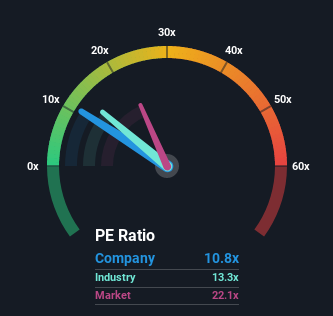- India
- /
- Metals and Mining
- /
- NSEI:JAIBALAJI
Earnings Working Against Jai Balaji Industries Limited's (NSE:JAIBALAJI) Share Price
With a price-to-earnings (or "P/E") ratio of 10.8x Jai Balaji Industries Limited (NSE:JAIBALAJI) may be sending very bullish signals at the moment, given that almost half of all companies in India have P/E ratios greater than 23x and even P/E's higher than 47x are not unusual. However, the P/E might be quite low for a reason and it requires further investigation to determine if it's justified.
Recent times have been quite advantageous for Jai Balaji Industries as its earnings have been rising very briskly. It might be that many expect the strong earnings performance to degrade substantially, which has repressed the P/E. If that doesn't eventuate, then existing shareholders have reason to be quite optimistic about the future direction of the share price.
View our latest analysis for Jai Balaji Industries

How Is Jai Balaji Industries' Growth Trending?
The only time you'd be truly comfortable seeing a P/E as depressed as Jai Balaji Industries' is when the company's growth is on track to lag the market decidedly.
Retrospectively, the last year delivered an exceptional 42% gain to the company's bottom line. Although, its longer-term performance hasn't been as strong with three-year EPS growth being relatively non-existent overall. Therefore, it's fair to say that earnings growth has been inconsistent recently for the company.
This is in contrast to the rest of the market, which is expected to grow by 20% over the next year, materially higher than the company's recent medium-term annualised growth rates.
In light of this, it's understandable that Jai Balaji Industries' P/E sits below the majority of other companies. It seems most investors are expecting to see the recent limited growth rates continue into the future and are only willing to pay a reduced amount for the stock.
What We Can Learn From Jai Balaji Industries' P/E?
Using the price-to-earnings ratio alone to determine if you should sell your stock isn't sensible, however it can be a practical guide to the company's future prospects.
We've established that Jai Balaji Industries maintains its low P/E on the weakness of its recent three-year growth being lower than the wider market forecast, as expected. At this stage investors feel the potential for an improvement in earnings isn't great enough to justify a higher P/E ratio. If recent medium-term earnings trends continue, it's hard to see the share price rising strongly in the near future under these circumstances.
There are also other vital risk factors to consider and we've discovered 4 warning signs for Jai Balaji Industries (2 are a bit unpleasant!) that you should be aware of before investing here.
If these risks are making you reconsider your opinion on Jai Balaji Industries, explore our interactive list of high quality stocks to get an idea of what else is out there.
New: Manage All Your Stock Portfolios in One Place
We've created the ultimate portfolio companion for stock investors, and it's free.
• Connect an unlimited number of Portfolios and see your total in one currency
• Be alerted to new Warning Signs or Risks via email or mobile
• Track the Fair Value of your stocks
Have feedback on this article? Concerned about the content? Get in touch with us directly. Alternatively, email editorial-team (at) simplywallst.com.
This article by Simply Wall St is general in nature. We provide commentary based on historical data and analyst forecasts only using an unbiased methodology and our articles are not intended to be financial advice. It does not constitute a recommendation to buy or sell any stock, and does not take account of your objectives, or your financial situation. We aim to bring you long-term focused analysis driven by fundamental data. Note that our analysis may not factor in the latest price-sensitive company announcements or qualitative material. Simply Wall St has no position in any stocks mentioned.
About NSEI:JAIBALAJI
Jai Balaji Industries
Manufactures and markets iron and steel products primarily in India.
Flawless balance sheet and slightly overvalued.
Similar Companies
Market Insights
Community Narratives



